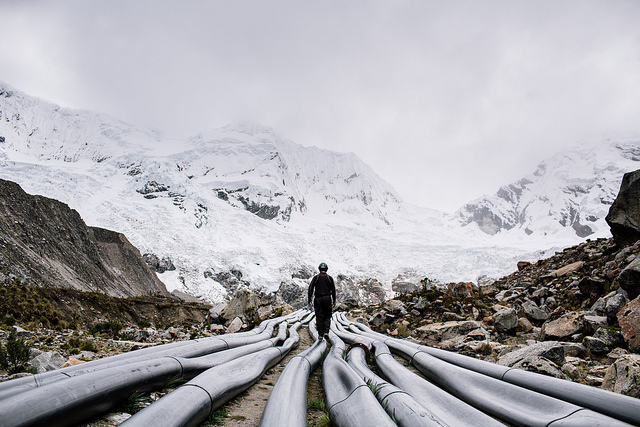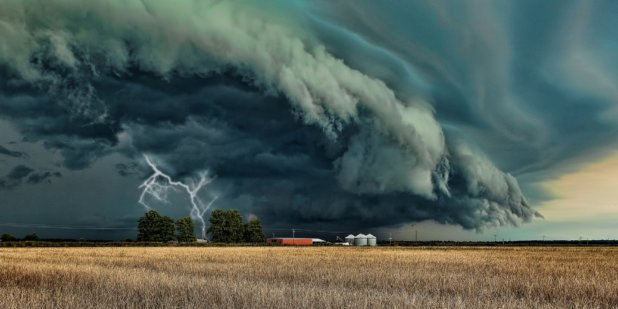- About
- Topics
- Picks
- Audio
- Story
- In-Depth
- Opinion
- News
- Donate
- Signup for our newsletterOur Editors' Best Picks.Send
Read, Debate: Engage.

The air is thin, the ascent difficult. Most of those who are heading towards the stunning mountain lakes start in Huaraz. Just about an hour by car and more than 1000 meters uphill separate the tranquil Andean town from the glaciers, which rise above Huaraz in a dizzy height. A brittle path, enclosed by two massive rock walls, leads visitors up to the "Palcacocha Lagoon". At the top, there is an idyllic postcard scenary. But appearance is deceptive.
"I ask RWE to take responsibility."
Saúl Luciano Lliuya has traveled a long way to say this line. Not only the country, but also his role are new to him. In front of the Court of Essen (Germany), the Peruvian farmer and mountaineer appears as plaintiff. Opposite, on the dock, representatives of the German utility RWE sat down.
At home in Peru, he fears for his hometown; in Germany he hopes for justice. And he's ready to stand up – like David against Goliath - and demand just that: justice.
At the foot of the "white mountain range," as the Peruvians call it, they're facing a great disaster. Thousands could fall victim to a huge flood, including Saúl Luciano Lliuya and his neighbors. It's due to global warming and to those who cause it. As a result of the temperature rise, the glaciers melt in the Andes and elsewhere. And north of Huaraz it's even worse. The white of the mountain peaks has turned grey.
The consequences are simple but cruel. The melting water causes the water level of the glacier lakes to rise permanently. They're about to spill. When the rocks of the mountains, which are no longer covered by snow, are getting loose and drop into the swollen lakes, enormous quantities of water might spill. In the case of the Palcacocha Lagoon, the water would irresistably roll downwards, as on a bowling alley.
In the valley, the densely populated Huaraz would have nothing to fight the water masses. There is an early warning system – in theory. Emergency plans are ready, but no one has read them.
"The poorest will be the first victims. In Peru, climate change is first and foremost a social question."
But what about RWE? We have nothing to do with it, they say. The company is thousands of kilometers away from the Andean city. And even if RWE's emissions are fueling global warming, the company can not be prosecuted for potential damage to somewhere as far away as Peru, according to RWE’s spokesman. But that is precisely what this unprecedented case is all about. A verdict might fill the gap between the cause and effect of climate change. It would be the first time in history.
The argument goes like this: First the temperatures rise, then the glaciers melt. And by burning coal RWE contributed significantly to that.
Around half a percent of all historical greenhouse gas emissions are attributable to the German utility. In court, Saúl Luciano Lliuya therefore not only calls RWE to take responsibility. RWE should also cover half a percent of the costs of protection measures in his home town, Lliuya claims. For RWE, it's not about really big money here. Still, the action was rejected at first instance. Now it is being negotiated at a higher level.
"Should the lawsuit finally be successful, the case could become a role model worldwide, experts believe."
Thomas Pogge, a professor at Yale University, is expecting plenty of lawsuits around the world that could bring companies to court. Climate change as a new field of law? Yes and no. Cases such as the one of Saúl Luciano Lliuya are new, but they are based on valid legal codes, for example in private and international law. It sounds trite, but the complaint against RWE is basically about a neighborhood dispute. Of course, between two neighbors who couldn't be more unequal.
fairplanet: Mr. Walker-Crawford, you assisted Saúl Luciano Lliuya in formulating scientific and legal arguments against RWE. Why did the first trial fail? What went wrong?
Noah Walker-Crawford: The court dismissed the case due to legal technicalities. This way it avoided addressing the issue of substance - whether an emitter such as RWE can be held legally responsible for the impacts of climate change. The fact that the appellate court has chosen to reopen the case indicates that the lower court may have not sufficiently considered the suit.
What do you expect from the second trial?
The higher court is reexamining the case from the beginning. Ideally the court will take this case seriously and examine the evidence. This would give Luciano Lliuya a fair chance to argue why RWE should be held responsible for its contribution to climate change. This November, he will travel to Germany to defend his case in the first scheduled hearing. Whether or not he wins the lawsuit, he already considers it a victory that he could bring his initiative for climate justice to an international stage.
Thank you very much.
Noah Walker-Crawford is an anthropologist and advisor to Saúl Luciano Lliuya. He assisted the claimant and his lawyers in formulating the scientific and legal arguments against RWE.
